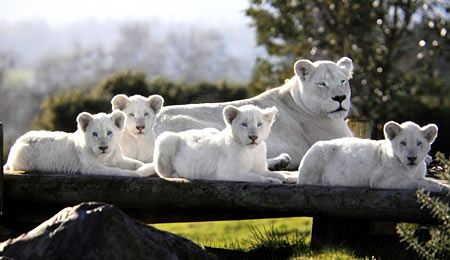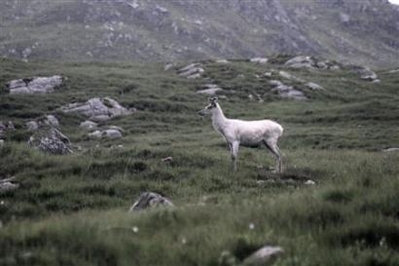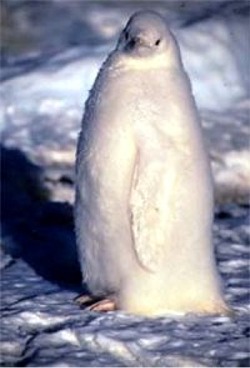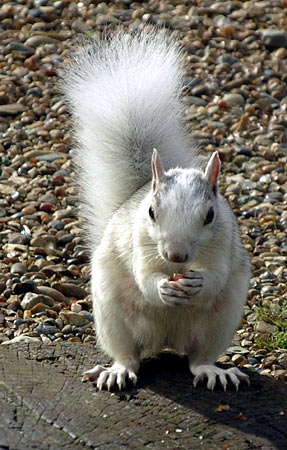Arthurian White Stag Reported
Posted by: Loren Coleman on February 13th, 2008

Almost mystical in nature, white animals garner human attention, as this new story demonstrates.
There is nothing truly cryptozoological about albino or nearly albino animals, any more than there is about melanistic ones. Neither are hidden, certainly, as their very appearance and finding them makes the news. Actually, their appeal has everything to do with them being very beautiful and visible.
In the world of weird animal news, white animals tend to get more than the usual attention from humans, and thus the media. Ghostly, phantomlike, mythical, and legendary are words often associated with albinos and near-albinos (leucistic) specimens of known species.
Here’s a roundup of one breaking and other “white animal” news bits and accompanying images.

A mythical and ghostly creature has appeared in the wilds of the Scottish Highlands — and has been caught on camera.
The rare white stag, from the red deer species, is believed to be among just a tiny handful living in Britain, according to a conservation group….
White stags are seen as a magical and powerful force in many mythologies.
The animal’s ghostly glow comes from a recessive gene which causes leucism, a condition which reduces the normal brown coloring in hair and skin. They are not albinos, which have red eyes due to lack of pigment.
In Celtic traditions, white stags represent messengers from the afterlife. Arthurian legend has it that the creature can never be caught — King Arthur’s pursuit of the animal represents mankind’s spiritual quest.
It is also said that for those who set eyes on the animal, a momentous moment is near.
“They say their appearance is meant to herald some profound change in life for those who encounter them — but I am still waiting,” said [John Muir Trust Partnership Manager Fran] Lockhart.“Ghost-like white stag spotted,” Reuters/John Muir Trust Handout, February 12, 2008.
Meanwhile, during the first week of January, 2008, it was reported scientists spotted a rare adult, unpigmented Adelie penguin (Pygoscelis adeliae) in Antarctica.

White penguins are indeed rare. In 1997, after more than 30 years of studying penguins in Antarctica, Gerald Kooyman a scientist at UCSD’s Scripps Institution of Oceanography reported what is believed to be the first sighting of an all-white emperor penguin (pictured above).

In May 2007, a Cumbria, UK, owner of two breeding African pygmy hedgehogs announced the birth of an albino offspring.


On February 12, 2008, internet photos of a new sighting of a white moose seen in Whitefish, Montana, began circulating.

Needless to say, white squirrels have been covered here at Cryptomundo in some detail, and more links to those blogs can be found easily enough.
About Loren Coleman
Loren Coleman is one of the world’s leading cryptozoologists, some say “the” leading living cryptozoologist. Certainly, he is acknowledged as the current living American researcher and writer who has most popularized cryptozoology in the late 20th and early 21st centuries.
Starting his fieldwork and investigations in 1960, after traveling and trekking extensively in pursuit of cryptozoological mysteries, Coleman began writing to share his experiences in 1969. An honorary member of Ivan T. Sanderson’s Society for the Investigation of the Unexplained in the 1970s, Coleman has been bestowed with similar honorary memberships of the North Idaho College Cryptozoology Club in 1983, and in subsequent years, that of the British Columbia Scientific Cryptozoology Club, CryptoSafari International, and other international organizations. He was also a Life Member and Benefactor of the International Society of Cryptozoology (now-defunct).
Loren Coleman’s daily blog, as a member of the Cryptomundo Team, served as an ongoing avenue of communication for the ever-growing body of cryptozoo news from 2005 through 2013. He returned as an infrequent contributor beginning Halloween week of 2015.
Coleman is the founder in 2003, and current director of the International Cryptozoology Museum in Portland, Maine.










What about white buffalos? The white buffalo is tremendously important in native-american mithology, is it not?
Has a white buffalo been sighted or photographed in recent times?
It’s easy to see why the occasional white animals was revered: they are lovely.
Where I live in Central NY we have an entire herd of white deer (whitetail deer), the largest wild white deer herd on the planet as I understand it. I see them often but every time I do it is still breathtaking. Though honestly I am always a bit taken back by seeing any deer. Stunning animals IMO.
We have a white Black Bear in our zoo in Winnipeg. It was captured in northern Manitoba (Easterville area) after it’s mother, a regular colored Black Bear, was killed by a car.
the last white stag in england (devon)? – shot, hung from a tree, and its head cut off by trophy hunters.
lets hope this one has more luck/lives in a very remote area/lives near a friendly band of hunt sabs.
Patsy: “It’s only a model!”
The white squirrel in the photo here looks like it’s actually a “chinchilla” patterned squirrel. The chinchilla pattern produces an animal with a pale – usually white – coat, each hair of which is tipped with a darker color, in this case black (note the “smudges” on the top of its head). The tipping is more noticable where the fur is short. White lions also are chinchilla patterned, in their case the coat is very pale cream or white, and since they are leucistic too, the hair is tipped with beige or fawn instead of black.
Animals with the chinchilla coat pattern are not albino. They have pigmented skin and eyes.
A gorgeous example of chinchilla patterning is the Chinchilla Persian cat (like the cat in the Fancy Feast commercials). They look white, because their fur is so long that the black tipping is only visible on close inspection, but their dark skin gives the eyes a beautiful “eyeliner” effect, and the light tipping on the snowy coat gives them a silvery appearance.